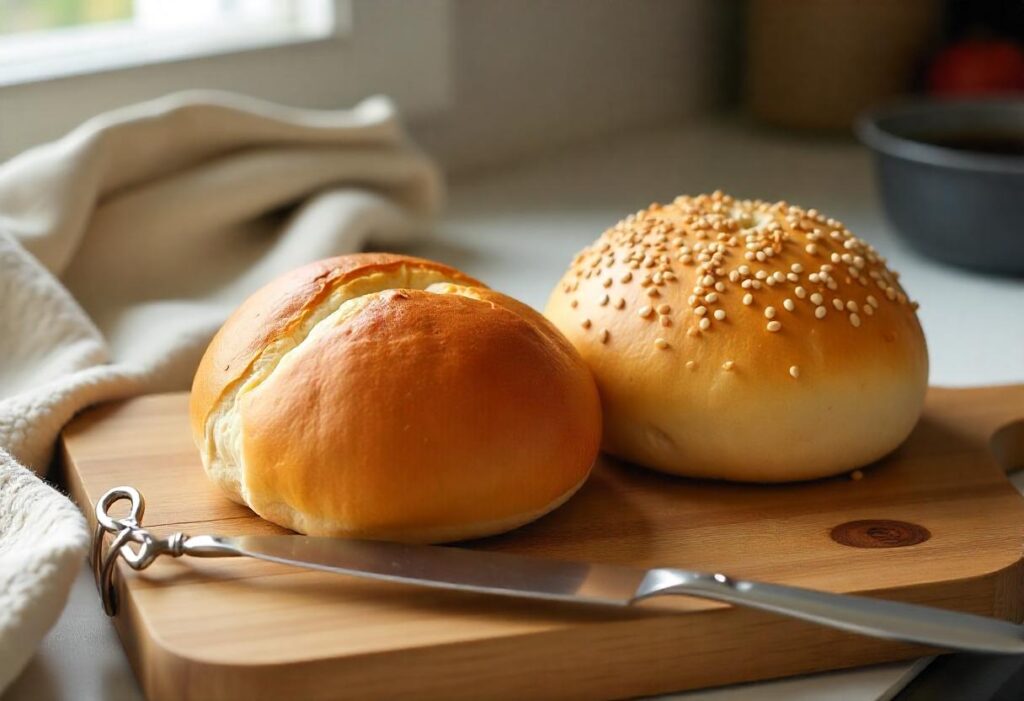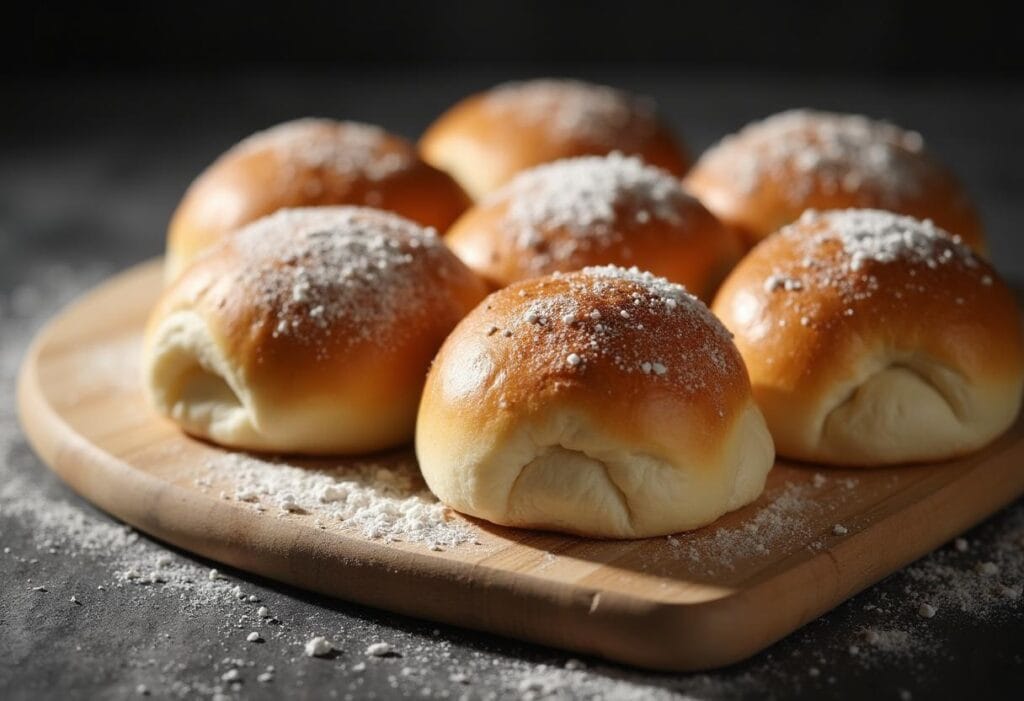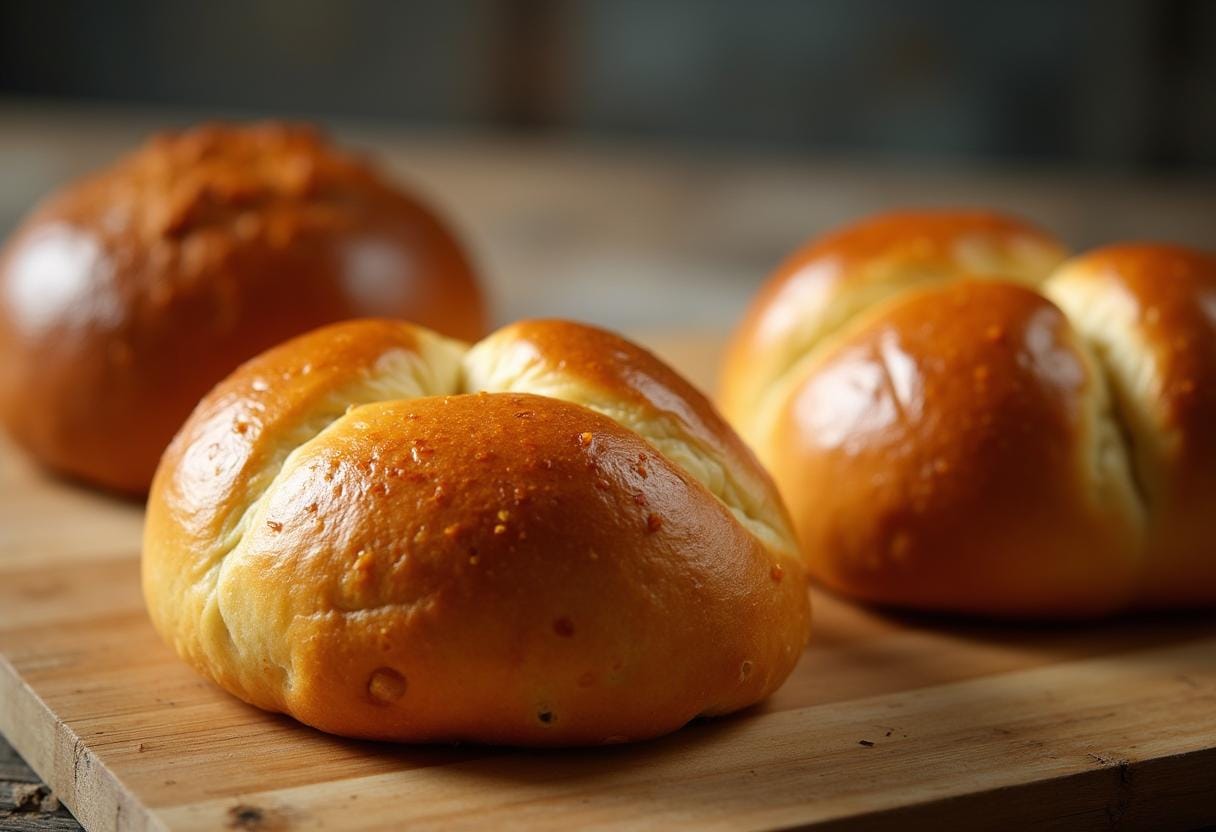Have you ever wondered what’s the difference between brioche and buns? While they might look similar at first glance, brioche and regular buns are worlds apart when it comes to ingredients, texture, and flavor. Understanding what’s the difference between brioche and buns can help you make better choices for your sandwiches, burgers, and other bread-based dishes.
From the buttery richness of brioche to the practicality of everyday buns, understanding these differences can help you choose the perfect bread for your next meal. Let’s dive into the delicious details and settle the brioche vs. buns debate once and for all.
Understanding Brioche: Key to What’s the Difference Between Brioche and Buns
What is Brioche?
Brioche is like the high-maintenance friend of the bread world—rich, luxurious, and oh-so-satisfying. Originally from France, this bread is a hybrid between a pastry and a loaf. Why? Because brioche isn’t just made with your typical bread ingredients like flour, water, yeast, and salt. Nope, it takes things up a notch by adding eggs, butter, and sometimes milk or cream into the mix.
If you’re curious about what makes brioche different from other breads, check out this detailed guide.
This bread is soft, tender, and slightly sweet, making it perfect for both savory and sweet dishes. Think French toast, burgers, or even a fancy bread pudding.
“Brioche is like a buttery cloud on your plate—light, airy, and irresistibly rich.”

The Origins of Brioche
The story of brioche goes way back to 15th-century France, where it was considered a luxury reserved for the wealthy. It wasn’t just bread; it was a status symbol. Over time, brioche became more accessible and found its way into bakeries worldwide. Today, it’s no longer just for the elite—though it still tastes pretty fancy!
Key Ingredients in Brioche
Brioche stands out because of its rich ingredients. Here’s a breakdown:
| Ingredient | Role in Brioche |
|---|---|
| Eggs | Adds richness and helps with the fluffy texture |
| Butter | Provides that melt-in-your-mouth flavor |
| Milk or Cream | Contributes to softness and slight sweetness |
| Sugar | Enhances the flavor and aids browning |
Texture and Flavor: What Makes Brioche Unique?
If you’ve ever torn into a brioche roll, you know the feeling—it’s like pulling apart a cloud. The crumb (the inside of the bread) is delicate and moist, while the crust is soft and golden-brown. The flavor? Buttery with just a hint of sweetness. It’s a bread that feels indulgent without being overwhelming.
A traditional French brioche loaf showcasing its soft texture and golden crust
What Are Buns?
Buns are the workhorses of the bread world. They’re simple, reliable, and everywhere—from fast-food joints to backyard barbecues. Buns are typically made with basic bread dough, meaning the ingredients are kept minimal: flour, water, yeast, and salt, with a touch of oil or sugar sometimes added for flavor.
Unlike brioche, buns are designed to complement rather than steal the show. They’re mild in flavor, making them the perfect vehicle for whatever you stack inside—burgers, pulled pork, or even a slab of peanut butter and jelly.

History and Evolution of Buns
Buns have been around for centuries, and their versatility is what keeps them popular. Originally, buns were small, round loaves made to be easily portioned and consumed. Over time, they evolved into specific types like burger buns, hot dog buns, and dinner rolls, adapting to cultural and culinary needs.
Common Types of Buns
Not all buns are created equal! Here’s a quick look at some popular varieties:
| Type of Bun | Typical Use |
|---|---|
| Burger Buns | Hamburgers, chicken sandwiches |
| Hot Dog Buns | Hot dogs, sausages |
| Slider Buns | Mini burgers, appetizers |
| Dinner Rolls | Side dishes, soups |
Ingredients and Texture: What Defines a Bun?
Buns have a soft, fluffy texture, but they’re more structured than brioche. This makes them ideal for holding up under heavy fillings like juicy burger patties or saucy pulled pork. The flavor is mild, allowing the star of the dish to shine.
“If brioche is a luxury sedan, buns are your trusty pickup truck—dependable, straightforward, and ready to get the job done.”
Key Insights: What’s the Difference Between Brioche and Buns
If you’ve been curious about what’s the difference between brioche and buns, the key distinctions are found in their ingredients, texture, and culinary applications.
Differences in Ingredients
To understand what’s the difference between brioche and buns, start with the ingredients. Brioche is enriched with butter and eggs, while buns rely on simpler components like flour and water.
| Aspect | Brioche | Buns |
|---|---|---|
| Fat Content | High (from butter and eggs) | Low to moderate |
| Sweetness | Slightly sweet | Neutral or slightly sweet |
Texture and Flavor Comparison
Brioche’s texture is softer, richer, and more tender than a typical bun. Meanwhile, buns are denser and chewier, making them sturdier for heavier fillings.
Uses in Culinary Applications
Brioche shines in dishes where its flavor and texture can be the star, like gourmet burgers or decadent desserts. Buns, on the other hand, are perfect for casual meals and sandwiches.
“Think of brioche as the tuxedo of bread, while buns are the everyday jeans and t-shirt.”
When to Choose Brioche Over a Regular Bun
Occasions for Brioche
Knowing what’s the difference between brioche and buns can help you decide when to choose one over the other. Brioche is perfect for elevating gourmet dishes, while buns are better suited for practical, everyday meals.
Looking for the best uses of brioche in sandwiches and hot dogs? Read more in this brioche buns guide.
- Gourmet Burgers: The slight sweetness of brioche complements the savory flavors of gourmet patties, cheeses, and toppings.
- French Toast: Brioche absorbs custard beautifully, creating a soft, indulgent breakfast.
- Bread Pudding: Its richness adds depth to this classic dessert.
- Pulled Pork Sliders: The tender crumb pairs wonderfully with the tangy, saucy meat.
Pairing Brioche with Specific Dishes
The beauty of brioche lies in its versatility. It works well with both sweet and savory flavors, making it a go-to choice for dishes that need a luxurious touch. Try pairing brioche with:
- Seafood Sandwiches: Crab or lobster rolls shine with brioche buns.
- Breakfast Sandwiches: The buttery richness enhances eggs, bacon, and cheese.
- Sweet Treats: Use brioche for Nutella-stuffed French toast or berry jam sandwiches.
When Regular Buns Are the Better Choice
Practicality and Versatility of Regular Buns
While brioche is luxurious, regular buns often win when practicality is key. They’re:
- Sturdier: Great for holding heavier fillings without falling apart.
- Affordable: Perfect for feeding a crowd on a budget.
- Neutral in Flavor: They let the fillings take center stage.
Budget-Friendly Benefits
Brioche can be pricey, especially if store-bought or freshly baked. Regular buns, on the other hand, are widely available and cost-effective. They’re ideal for casual meals, picnics, and gatherings where you need to serve many people without breaking the bank.
“For everyday meals, regular buns offer the perfect balance of simplicity and functionality.”
Common Problems and Solutions When Using Brioche or Buns
Brioche Drying Out Quickly
Brioche’s high fat content can cause it to stale faster than regular buns. To keep it fresh:
- Store Properly: Wrap it tightly in plastic wrap or store in an airtight container.
- Freeze: Brioche freezes well and can be thawed for later use without losing its quality.
Choosing the Right Bun for Your Recipe
Not all buns are created equal, and picking the wrong one can ruin your dish. For example:
- Use soft buns for burgers to ensure they don’t overpower the patty.
- Choose dense buns for saucy fillings to avoid sogginess.
Overcoming Stale Breads
Both brioche and buns can lose their freshness, but you don’t have to throw them out. Here’s how to revive them:
- Steam Them: A quick steam can soften stale bread.
- Make Breadcrumbs: Blend stale bread into crumbs for casseroles or breading.
- Toast Them: Slightly stale bread works great for toasting or grilling.
Brioche vs. Buns in Popular Culture
How Chefs Use Brioche
Chefs often turn to brioche when they want to add a touch of luxury to their dishes. From fine dining restaurants to gourmet food trucks, brioche is featured in:
- Lobster Rolls: The buttery bread enhances the delicate flavor of lobster.
- High-End Burgers: Brioche is often the bun of choice for premium beef patties.
- Desserts: Pastry chefs use brioche for pudding, tarts, and more.
Buns in Fast Food and Street Food
Regular buns dominate the fast-food world, and for good reason. They’re:
- Affordable: Perfect for high-volume businesses.
- Practical: Their sturdiness makes them ideal for quick assembly and transport.
- Familiar: Their mild flavor appeals to a wide audience.
How to Make Brioche and Buns at Home

Homemade Brioche Recipe
Making brioche at home can be a rewarding experience. Here’s a simple recipe:
Ingredients:
- 4 cups all-purpose flour
- 1/3 cup sugar
- 1 tsp salt
- 1 packet active dry yeast
- 1/2 cup milk (warm)
- 5 eggs
- 1 cup unsalted butter (softened)
Steps:
- Combine warm milk, sugar, and yeast. Let it foam for 5-10 minutes.
- Mix flour and salt in a bowl. Add the yeast mixture and eggs.
- Knead the dough until smooth, then incorporate the butter.
- Let the dough rise for 1-2 hours.
- Shape into rolls and bake at 375°F (190°C) for 20-25 minutes.
Easy Bun Recipe for Beginners
If you’re looking for a straightforward bun recipe, this is it:
Ingredients:
- 3 1/2 cups flour
- 2 tbsp sugar
- 1 1/4 tsp salt
- 1 tbsp yeast
- 1 cup warm water
- 2 tbsp oil
Steps:
- Mix yeast, sugar, and warm water. Let it sit for 5 minutes.
- Add flour, salt, and oil. Knead into a dough.
- Let rise for 1 hour.
- Shape into buns and bake at 375°F (190°C) for 15-20 minutes.
Creative Variations of Brioche and Buns
Flavored Brioche Options
Brioche doesn’t always have to stick to its classic buttery flavor. Many bakers experiment with flavors to suit different tastes and occasions. One popular variation is apple cinnamon brioche rolls, which add a warm, spiced twist to the traditional bread. Try this delicious recipe for a new take on brioche.
- Chocolate Brioche: Infused with cocoa or filled with chocolate chips, perfect for dessert lovers.
- Savory Brioche: With herbs, garlic, or cheese, this twist is ideal for pairing with soups or stews.
- Holiday Brioche: Enhanced with dried fruits, spices like cinnamon, or orange zest, often served during festive seasons.
Unique Bun Styles Around the World
Buns vary widely across cultures, showcasing unique ingredients and uses. Some examples are:
- Bao Buns: A Chinese steamed bun often filled with pork or vegetables.
- Brioche-Style Buns: Common in fusion cuisines, combining the richness of brioche with the practicality of buns.
- Pretzel Buns: Dense and chewy, with a distinct salty crust, perfect for gourmet burgers.
Nutritional Comparison Between Brioche and Buns
Understanding the nutritional differences between brioche and buns can help you make informed choices. If you’re wondering about how brioche compares to milk bread, check out this comparison article.
| Nutrient | Brioche (per 100g) | Regular Bun (per 100g) |
|---|---|---|
| Calories | ~330 kcal | ~250 kcal |
| Fat | ~14g | ~3g |
| Protein | ~8g | ~9g |
| Carbohydrates | ~45g | ~50g |
While brioche is higher in fat and calories due to its rich ingredients, regular buns offer a lower-calorie, leaner option. Depending on your dietary goals, you can choose what works best for you.
Tips for Perfect Brioche and Bun Pairings
Pairing the right bread with the right dish can elevate your meal.
- With Juicy Burgers: Opt for brioche if you want a soft, buttery base. Regular buns work better for extra-saucy toppings.
- For Sandwiches: Use regular buns for deli meats and brioche for gourmet fillings like smoked salmon.
- With Sweet Fillings: Brioche is ideal for pairing with sweet spreads like honey, Nutella, or fruit compotes.
The Role of Brioche and Buns in Modern Cuisine
The rise of gourmet dining has led to an increased appreciation for brioche, especially in upscale burgers, seafood sliders, and desserts. Similarly, buns remain a staple in fast food and casual dining, beloved for their versatility.
Brioche is now frequently used in fusion cuisines, where its richness enhances dishes like spicy fried chicken sandwiches. Regular buns, on the other hand, have evolved with whole-grain, gluten-free, and vegan options catering to modern dietary preferences.
FAQs
How is brioche different from regular bread?
Brioche contains eggs, butter, and sometimes milk or cream, making it richer and softer than regular bread.
Can I use brioche instead of regular buns?
Yes, but keep in mind that brioche is sweeter and more delicate, which may not suit all dishes.
Why do brioche buns cost more?
The higher cost of ingredients like butter and eggs makes brioche more expensive to produce.
What’s the best way to store brioche?
Wrap it tightly in plastic or store it in an airtight container. Freezing is also a good option.
Are regular buns healthier than brioche?
Regular buns typically have fewer calories and less fat than brioche because they lack rich ingredients like butter and eggs.
Can I make brioche without a stand mixer?
Yes, but it requires more effort to knead the dough by hand due to its sticky consistency.
Conclusion:
The Final Verdict on Brioche and
When examining what’s the difference between brioche and buns, it all boils down to your needs. For indulgence and flavor, brioche takes the crown But for practicality and versatility, regular buns are hard to beat. Whether you’re hosting a gourmet dinner or a casual barbecue, choosing the right bread can make all the difference.
Now that you know what’s the difference between brioche and buns, you can confidently select the right bread for any occasion, whether it’s a luxurious dinner or a casual lunch.

